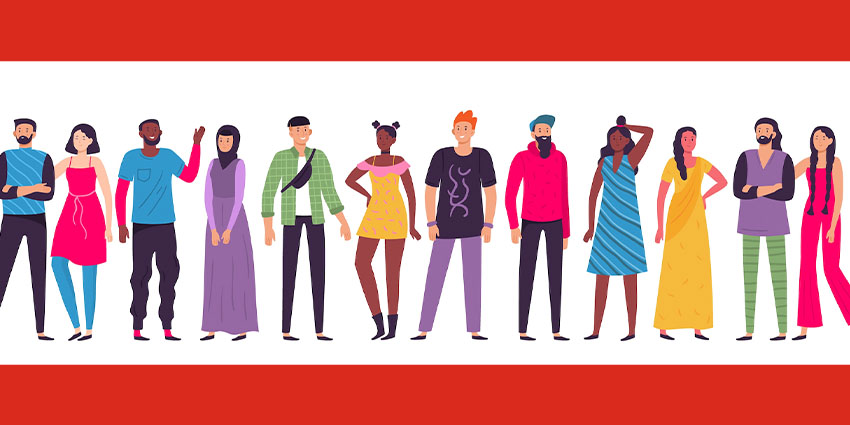Human-centered design is a problem-solving strategy that places real people at the center of the development process, allowing companies to build products, services, and experiences that connect with their customer base. It was popularized by global design firm IDEO, which defined it as “a creative approach to problem-solving.”
The objective is to keep consumers’ desires, preferences, and dislikes in mind throughout the entire customer experience design process. As a result, companies can create more relevant customer journeys that will likely generate a bigger profit.
Applying the Three Stages of Human-Centered Design to CX
Human-centered design consists of three phases: inspiration, ideation, and implementation.
During the inspiration phase, the organization learns directly from the consumer they are creating for as they immerse themselves in their lives to understand their demands and desires deeply.
The CX team makes sense of lessons gained, discovers possibilities for design optimization, and prototypes potential solutions during the ideation phase.
In the implementation phase, companies learn from their tests, optimize the design, and embed customer journey enhancements.
Here is a more comprehensive overview of each of the three stages.
- Inspiration
This initial phase is devoted to gathering customer feedback. Instead of developing CX based on preconceived conceptions of what the customer wants, the organization takes the time to understand what the customer genuinely desires.
The inspiration phase often involves getting to grips with the feelings and emotions of customers. CX teams put themselves in consumers’ shoes and typically ask them questions to identify what goods they’re presently using, why and how they’re using them, and what problems they’ve experienced.
“The jobs to be done” theory of Harvard Business School professor Clayton Christensen is a valuable idea to consider. In this context, consumers do not choose a product for its core characteristics but rather employ it to accomplish a specific objective.
By viewing CX aspects through this lens, one may begin to design user experiences based on their motivations, as opposed to traditional consumer characteristics like age, gender, income, and marital status.
To learn more about this theory, check out the video below:
- Ideation
The first phase’s inspiration (or, more precisely, intelligence) will lead to the second phase: ideation. During this phase, teams generate as many ideas as feasible based on the collected input.
Then, it is time to develop a prototype for testing and receiving feedback after zeroing in on the most realistic and viable ideas. It could be something as making one tweak to a customer journey touchpoint.
Whatever the case, the goal is to test the ideas, get user feedback, build on those suggestions, and then re-evaluate them until conceptualizing an optimal experience.
- Implementation
Bringing the ideal customer experience to market is the last phase of the process. Making the new journey operationally valuable for each department is central to such a strategy, ensuring that employees do not settle back into old routines.
Building on this, consider how the culture must change to fit the new experience, depending on the extent of the transformation. Also, when expanding the scope of the CX transformation, companies must continue to gather and evaluate feedback, engaging in CX optimization.
Indeed, as client demands and requirements continue to develop, the iteration process should never cease. After all, the objective of human-centered design is to adjust CX to suit user needs. Keeping people at the core of the CX development process will guarantee that businesses achieve strong alignment and constant innovation.
Best Practices for Human-Centered CX Design
To succeed with a blueprint for human-centered CX design, consider the following best practices:
- Maintain an open mind and avoid fitting customer feedback – in the inspiration stage – around preconceived narratives. Employing multiple techniques for gathering customer feedback will help here.
- Create a set of customer promises and commitments after the initial research. Doing so may help to surface improvement opportunities within the existing customer journey.
- Test CX design with real users. After all, prototyping is one of the most critical aspects of developing a human-centered experience.
Why Is Human-Centered Design So Important?
According to the NTT Global Customer Experience Benchmarking Report 2021, consumer and corporate perspectives on customer experience are fundamentally different. Indeed, 75 percent of companies are satisfied with the digital customer experience they offer, compared to 35 percent of consumers.
Human-centered design can help to overcome this CX gap. According to Clare Muscutt, Founder of CMXperience and Women in CX, the pandemic caused businesses to make hasty choices that resulted in unpleasant tradeoffs. This has furthered the divide between corporate and individual aspirations.
Muscutt advocates human-centered digital transformation architecture as the remedy for this dilemma. She exclusively told CX Today:
“We can unite the organization around consumer and employee experiences that break down barriers and silos between teams, and then build a new future where everything works exceptionally well for everyone, including the business.”
Finding a mechanism to map the existing customer journey is crucial to success. One of the disadvantages of digital-first customer service is that companies often fail to discover where the issues are since it is often difficult to garner feedback through digital channels. For customers, it is easy to ignore the request.
To rectify this, Muscutt suggests speaking with consumers, analyzing current data, and recruiting consumers to discuss their experiences. She stated:
“I often find conversing with folks who complain the most to be a good source of information. When dealing with customers who have escalated a complaint, it is crucial to determine why this occurred and what prompted their displeasure.”
Discover more expert insights from Clare by checking out the following video: How to Survive & Thrive in the New CX Jungle







